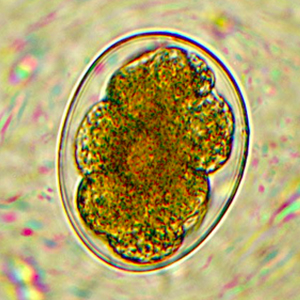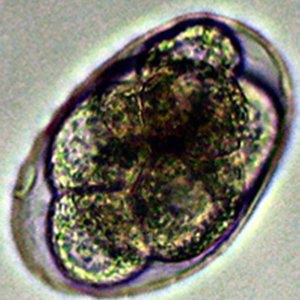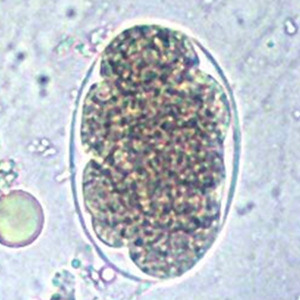Necator americanus is a hookworm of primates. It is important to note that this species istransmissible to humans.
Epidemiology
Necator americanus has a cosmopolitan distribution and is described in New and Old-World Monkeys, as well as in Apes. It has notably been reported in spider monkeys (Ateles spp.), common marmosets (Callithrix jacchus), capuchin monkeys (Cebus capucinus), mandrills (Mandrillus sphinx), baboons (Papio spp.), gibbons (Hylobatidae), chimpanzees (Pan spp.), orangutans (Pongo spp.) and gorillas (Gorilla gorilla) (Strait et al., 2012; Calle & Joslin, 2015; Murphy, 2015; Solórzano-García & de León, 2018; Medkour et al., 2020).
Description
Necator americanus eggs have a typical hookworm egg morphology. They cannot be differentiated from Ancylostoma eggs using coproscopy alone (Strait et al., 2012).
Differential diagnosis
The main differential diagnosis for Necator americanus is Ancylostoma spp. To a larger extent, Necator americanus should not be confused with any other non-embryonated strongyle eggs.
Clinical significance
Clinical signs associated to Necator americanus infection include anemia, eosinophilia, expiratory dyspnea, abdominal distention, generalized weakness and even death in debilitated individuals, for both humans and non-human primates (Strait et al., 2012; Calle & Joslin, 2015; Murphy, 2015).
Prophylaxis and treatment
As Necator americanus is reported to be transmissible to humans, hygienic measures need to be taken in case of diagnosis.
Various treatments have been described to treat hookworm infections in non-human primates, namely (Strait et al., 2012):
- Ivermectin: 200 µg/kg IM once, repeated 3 weeks later if necessary;
- Tetramisole: 12-16 mg/kg once PO;
- Mebendazole: 15 mg/kg PO 2 days OR 4 mg/kg PO 10 days;
- Levamisole: 7,5 mg/kg SC twice two weeks apart.




